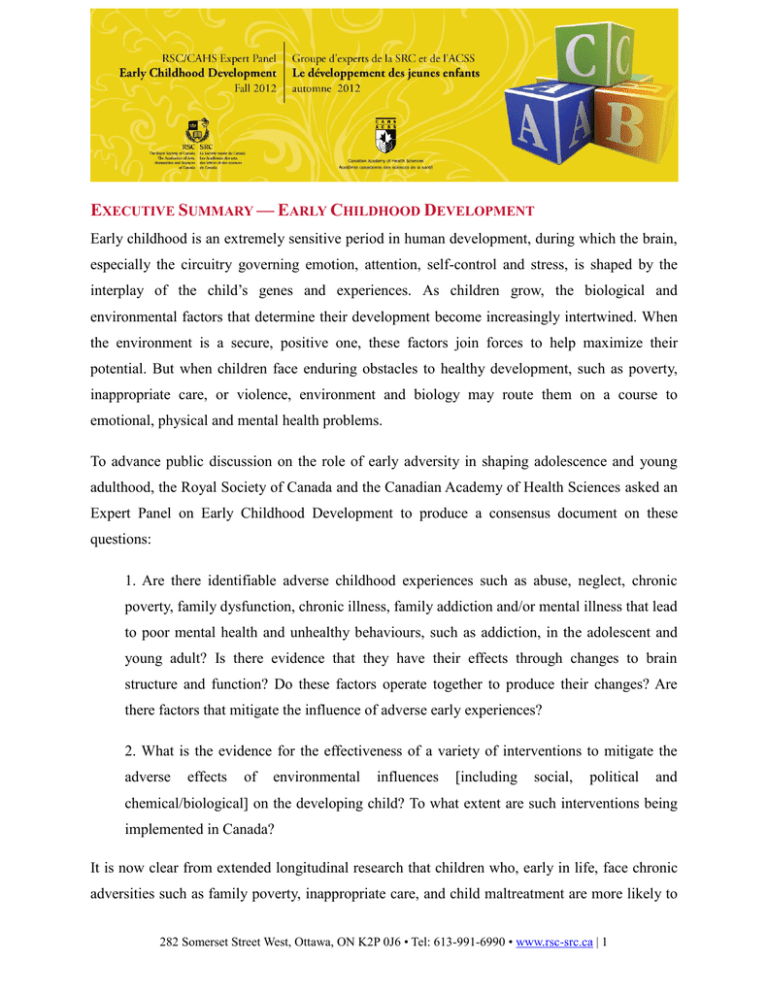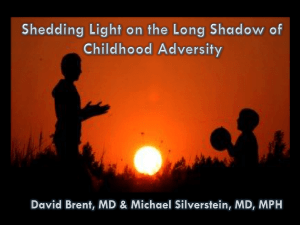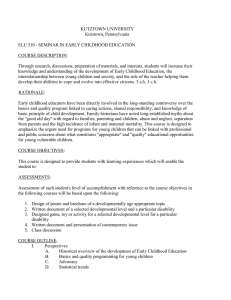Early childhood is an extremely sensitive period in human
advertisement

EXECUTIVE SUMMARY — EARLY CHILDHOOD DEVELOPMENT Early childhood is an extremely sensitive period in human development, during which the brain, especially the circuitry governing emotion, attention, self-control and stress, is shaped by the interplay of the child’s genes and experiences. As children grow, the biological and environmental factors that determine their development become increasingly intertwined. When the environment is a secure, positive one, these factors join forces to help maximize their potential. But when children face enduring obstacles to healthy development, such as poverty, inappropriate care, or violence, environment and biology may route them on a course to emotional, physical and mental health problems. To advance public discussion on the role of early adversity in shaping adolescence and young adulthood, the Royal Society of Canada and the Canadian Academy of Health Sciences asked an Expert Panel on Early Childhood Development to produce a consensus document on these questions: 1. Are there identifiable adverse childhood experiences such as abuse, neglect, chronic poverty, family dysfunction, chronic illness, family addiction and/or mental illness that lead to poor mental health and unhealthy behaviours, such as addiction, in the adolescent and young adult? Is there evidence that they have their effects through changes to brain structure and function? Do these factors operate together to produce their changes? Are there factors that mitigate the influence of adverse early experiences? 2. What is the evidence for the effectiveness of a variety of interventions to mitigate the adverse effects of environmental influences [including social, political and chemical/biological] on the developing child? To what extent are such interventions being implemented in Canada? It is now clear from extended longitudinal research that children who, early in life, face chronic adversities such as family poverty, inappropriate care, and child maltreatment are more likely to 282 Somerset Street West, Ottawa, ON K2P 0J6 • Tel: 613-991-6990 • www.rsc-src.ca | 1 experience a broad range of impairments later in life. These difficulties range from emotional, behavioral, interpersonal, school and stress-related adjustment problems, to more severe difficulties such as mental health problems, delinquency and criminal offending. Needless to say, these difficulties may have dire consequences for the individual and society. Early adversity and later developmental health are linked through the structural and functional development of specific brain and nervous system circuits, most notably the stress-response system. These brain development processes are partly governed by complex gene-environment interactions affecting the expression of genes. By gene-environment interaction, we mean that (multiple) genes convey a general susceptibility that may result in a negative outcome depending upon the child’s experience of environmental stressors. Our genes do not determine our traits; rather there is a dynamic interplay between nature (genes) and nurture (environment). Developmental trajectories appear early in life and then tend to be reinforced subsequently through a cascade of differential exposures to stressful and risky social contexts. This report outlines an emerging science, which integrates genetics, epigenetics, neuroscience and developmental science, and that will transform our knowledge of early development by providing a deeper understanding of how the environment and biology jointly influence development over the life course. Here are some of the issues raised by this new science: Genes listen to the environment, and their expression is partly influenced by experience. Recent advances in epigenetics, mainly using animal models, now provide us with mechanisms that explain how this may happen biologically. There is emerging evidence in humans suggesting that brain development could be partly molded through changes in gene expression, embedding early experience in our biology and leading to individual differences in developmental health trajectories. More research is necessary to tell to what extent this is the case. Exposure to early adversity is a significant predictor of later problems, but not inevitably in all children. Rather, children vary tremendously in their response to adverse childhood experiences; there is no single path from early adversity to poor social, emotional, cognitive, and mental health outcomes. The effects of early adversity are moderated by a wide range of factors, from genes to community-level social support. 282 Somerset Street West, Ottawa, ON K2P 0J6 • Tel: 613-991-6990 • www.rsc-src.ca | 2 Early childhood is a sensitive period when children may be more susceptible to both negative and positive exposures. Some children may be more biologically susceptible to social context than others, and thus more predisposed to react to both stressful and nurturing environments. These children could also experience the most gains from intervention. Adverse childhood experiences are not just about dramatic events; day-to-day interactions in children’s lives are more important than we previously understood. It is the chronic exposure to maltreatment, poor parenting and other adversity rather than an individual occurrence of maltreatment that is most damaging to developmental health. The biological systems and pathways linking adverse childhood experiences to biology and behavior also extend to the regulation of parenting behaviors. We need to invest in services aimed at enhancing and supporting sensitive and effective parenting in various contexts. Such support should be ongoing and complemented through childcare, school and community programs aimed at laying the foundations of better health and preventing addictions and mental health problems. Beyond parenting, broader factors—at the level of the extended family (e.g., grandparents, aunts), community and society—also play an important developmental role. We need to understand how and to what extent these factors affect child development. There is now a limited but promising body of research showing that child maltreatment, perhaps the most serious adversity that children may encounter, and its associated outcomes can be reduced if targeted, intensive and sustained services are deployed. In contrast, there is a paucity of credible research evidence on how broader interventions at the level of the community might influence adverse childhood experiences in ways that, in turn, would influence long-term developmental outcomes. While poverty is a key risk factor for child maltreatment, it is rarely addressed in child maltreatment intervention programs. The success of intense, sustained prevention programs targeting high-risk families around birth and early childhood underlines that time as a high-priority window for intervention. 282 Somerset Street West, Ottawa, ON K2P 0J6 • Tel: 613-991-6990 • www.rsc-src.ca | 3



